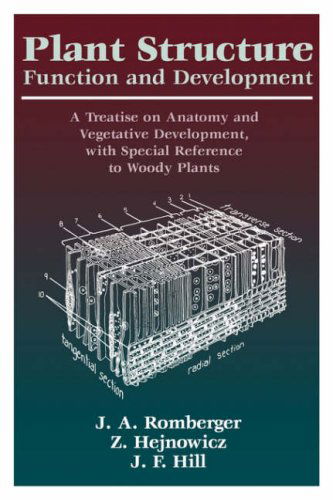
Tell your friends about this item:
Plant Structure: Function and Development 1st edition
J.f. Hill
Plant Structure: Function and Development 1st edition
J.f. Hill
Originally published in 1993, and long out-of-print, this book has become a classic. The book covers the developmental anatomy of large, complex plants, particularly of perennial shrubs and trees that grow and survive for decades and centuries. The book is focused on the meaning of that anatomy, the integrated structure, as a determinant of effective function. A pervading theme is that the plant structures that have "survived" evolution within the larger context of geologic and climatic evolution are well attuned to biochemical and biophysical principles that determine and define efficient function. This book is intended for those who have already studied the anatomy and development of plants. It is addressed to advanced students, teachers and researchers in the broad, interrelated fields of botany, forestry, horticulture and agronomy, and to others having professional interests in the culture of woody plants and the stewardship of ecosystems. It is especially addressed to those who, by study and research, seek to narrow the wide gap between the cellular and molecular biology approaches to understanding the format and content of inherited information, and the actual morphogenesis and integrated functioning of higher plant organisms. The book is focused on vegetative growth and development. Limitations of space precluded a treatment of reproductive development and of morphogenesis in fruits and seeds. The authors, however, have included a chapter on embryogeny as the beginning of development of the individual higher plant organism. "Plant Structure: Function and Development, first published in 1993, remained in print for such a short time that many of us missed the opportunity to purchase a copy (I have been working with a tattered photocopy for the past 7 years). The authors note in the preface that "complex plants, particularly woody plants . . . have survived eons of organismal evolution" and as such "are well attuned to biochemical and biophysical principles that determine and define efficient function." Too often plant anatomy has been treated in isolation from its' all-important functional significance. The authors of this book provide a welcome and well-developed bridge between structure and physiology, as well as providing the developmental aspects critical to a complete understanding. Not only does the book provide valuable insights for biologists studying extant plants (including applied areas of horticulture, agronomy and forest biology), but it is also, in my view, a valuable resource for paleobotanists, particularly those interested the rapidly growing area of paleo-ecophysiology. Often woody plants are given only cursory attention in plant structure texts, but not so here. Both Romberger and Hejnowicz spent their professional careers studying woody plants, and their insights are critical to the success of this treatise. Although the book is primarily a very turgid reference source, it could also serve as a text for advanced undergraduate or graduate courses - and then would become a valuable library addition for those students." Richard Jagels Professor of Forest Biology University of Maine
| Media | Books Paperback Book (Book with soft cover and glued back) |
| Released | April 1, 2004 |
| ISBN13 | 9781930665958 |
| Publishers | The Blackburn Press |
| Pages | 524 |
| Dimensions | 725 g |
| Language | English |
See all of J.f. Hill ( e.g. Paperback Book )

 Christmas presents can be returned until 31 January
Christmas presents can be returned until 31 January

